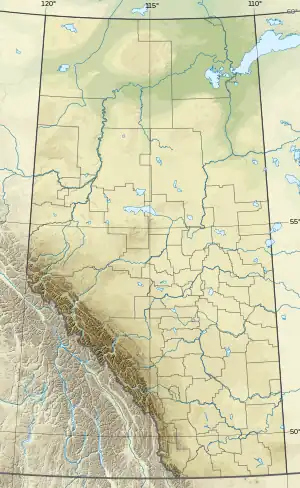Smith | |
|---|---|
 Smith Location of Smith  Smith Smith (Alberta) | |
| Coordinates: 55°09′46″N 114°02′13″W / 55.16278°N 114.03694°W | |
| Country | Canada |
| Province | Alberta |
| Region | Northern Alberta |
| Census division | 17 |
| Municipal district | Municipal District of Lesser Slave River No. 124 |
| Government | |
| • Type | Unincorporated |
| • Governing body | Municipal District of Lesser Slave River No. 124 Council |
| Area (2021)[1] | |
| • Land | 2.42 km2 (0.93 sq mi) |
| Population (2021)[1] | |
| • Total | 227 |
| • Density | 93.7/km2 (243/sq mi) |
| Time zone | UTC−07:00 (MST) |
| • Summer (DST) | UTC−06:00 (MDT) |
| Area code(s) | 780, 587, 825 |
| Waterways | Athabasca River, Lesser Slave River |
Smith is a hamlet in northern Alberta, Canada within the Municipal District of Lesser Slave River No. 124.[2] It is located on Highway 2A, approximately 182 kilometres (113 mi) northwest of Edmonton, at the confluence of the Lesser Slave River and the Athabasca River.
History
The settlement of Smith began in 1914 after the Edmonton, Dunvegan and British Columbia Railway had reached the present location of the hamlet. The arrival of railway resulted in subdivision of the townsite.[3]
As a result of the establishment of Smith, the previously established Village of Port Cornwall located 1.4 km (0.87 mi) to the northwest, across the Athabasca River on the north shore of Lesser Slave River, began to deteriorate. Subsequently, Port Cornwall dissolved from village status on September 11, 1917.[4]
Demographics
In the 2021 Census of Population conducted by Statistics Canada, Smith had a population of 227 living in 90 of its 101 total private dwellings, a change of 53.4% from its 2016 population of 148. With a land area of 2.42 km2 (0.93 sq mi), it had a population density of 93.8/km2 (242.9/sq mi) in 2021.[1]
As a designated place in the 2016 Census of Population conducted by Statistics Canada, Smith had a population of 148 living in 55 of its 76 total private dwellings, a change of -32.1% from its 2011 population of 218. With a land area of 2.45 km2 (0.95 sq mi), it had a population density of 60.4/km2 (156.5/sq mi) in 2016.[5]
See also
References
- 1 2 3 "Population and dwelling counts: Canada and designated places". Statistics Canada. February 9, 2022. Retrieved February 10, 2022.
- ↑ "Specialized and Rural Municipalities and Their Communities" (PDF). Alberta Municipal Affairs. January 12, 2022. Retrieved January 21, 2022.
- ↑ Leonard, David; Stelfox, Brad; Wynes, Bob (September 1999). "A Physical, Biological and Land Use Synopsis of the Boreal Forest's Natural Regions of Northwest Alberta, Chapter 6 – Humans: Their Demographics, Employment, & Infrastructure" (PDF). Retrieved July 5, 2011.
- ↑ "Notice – Village of Port Cornwall (excerpt from The Alberta Gazette, September 29, 1917)" (PDF). Alberta Municipal Affairs. September 29, 1917. Retrieved July 5, 2011.
- ↑ "Population and dwelling counts, for Canada, provinces and territories, and designated places, 2016 and 2011 censuses – 100% data (Alberta)". Statistics Canada. February 8, 2017. Retrieved February 13, 2017.
External links